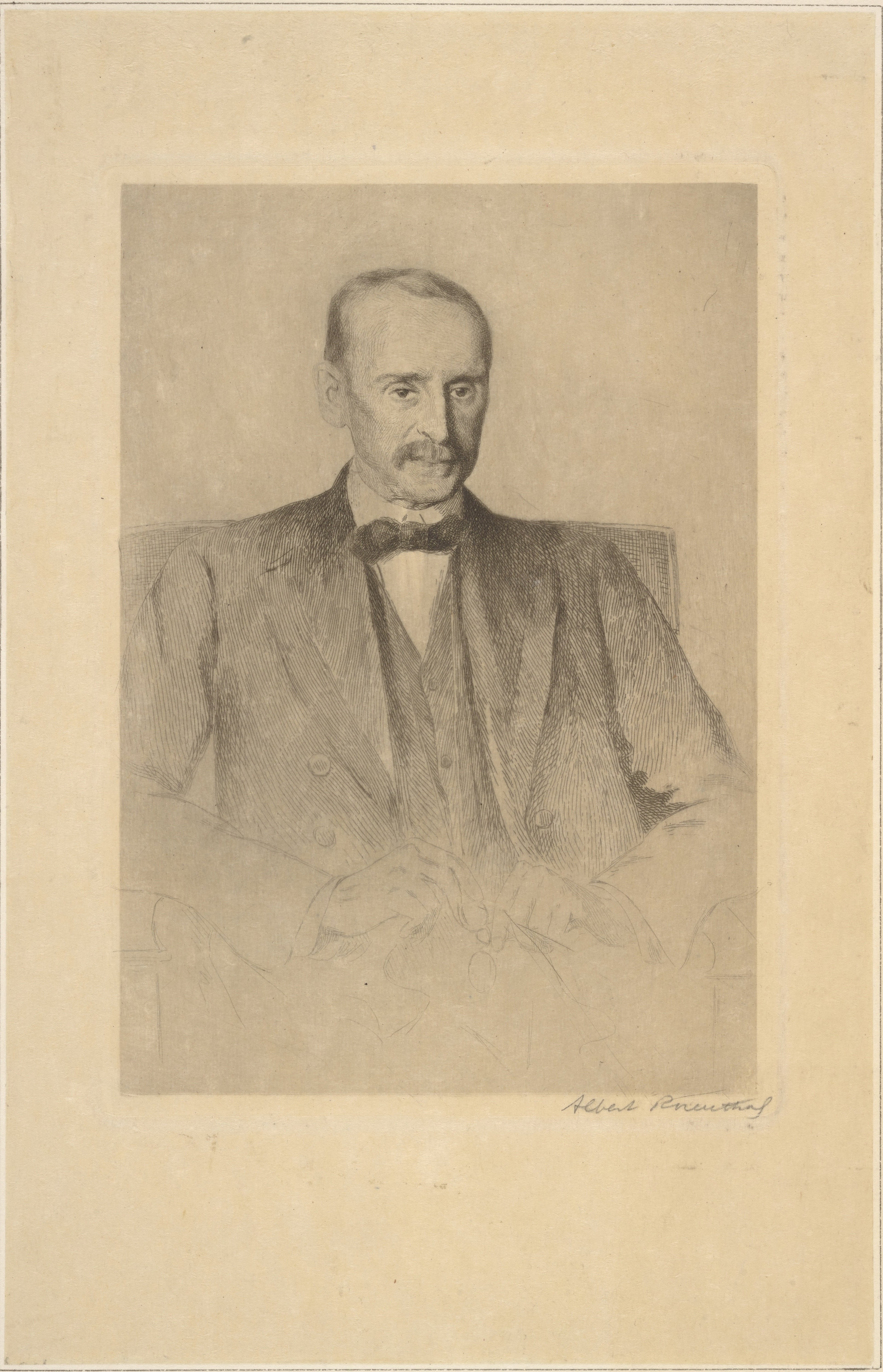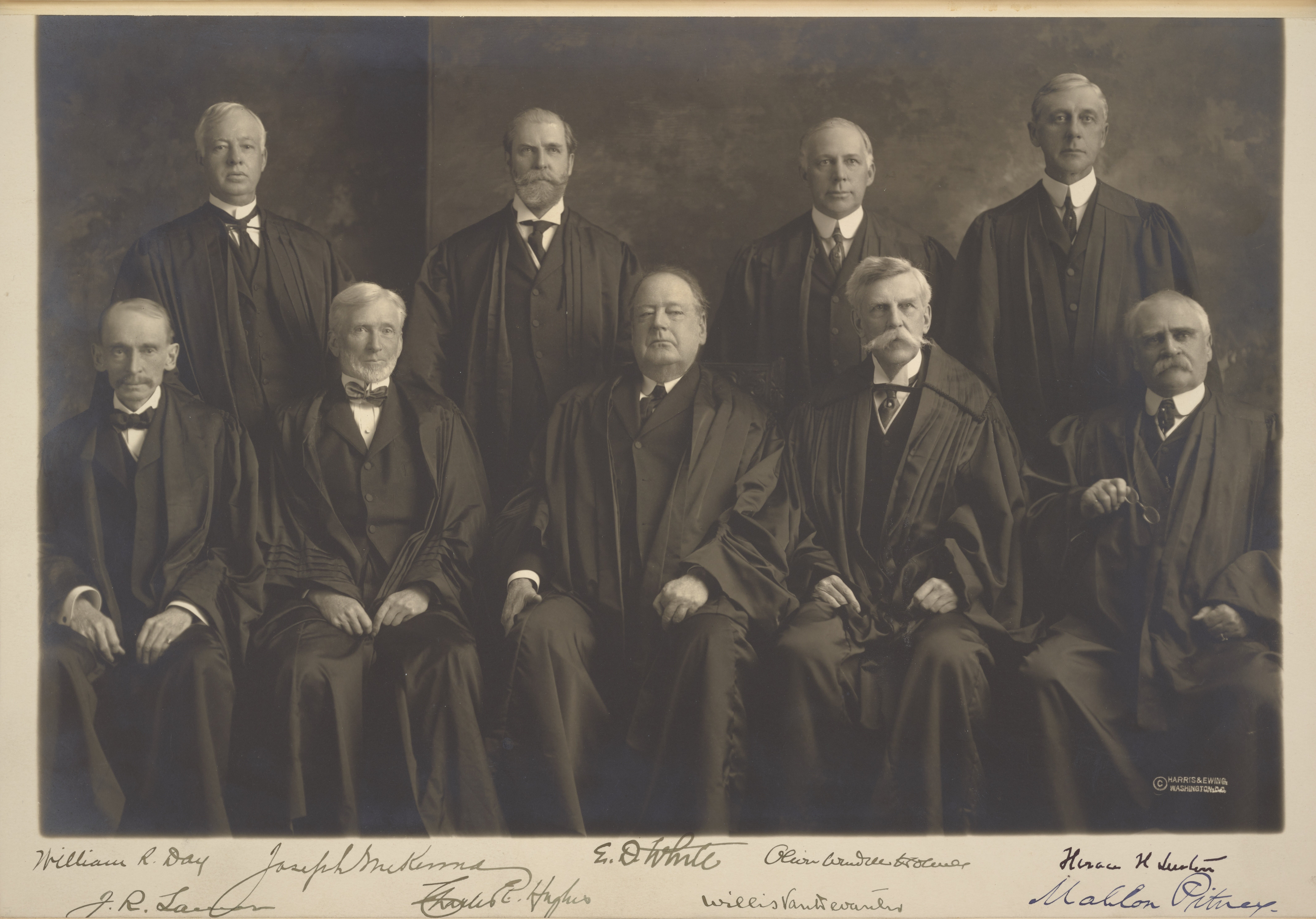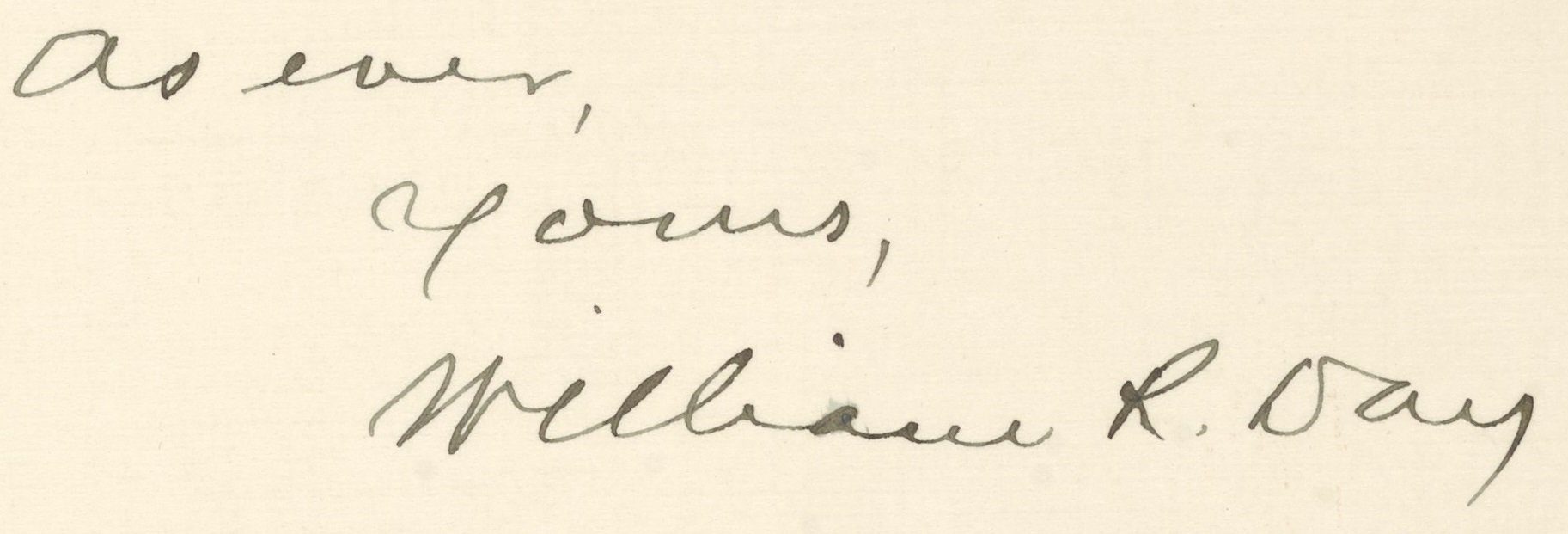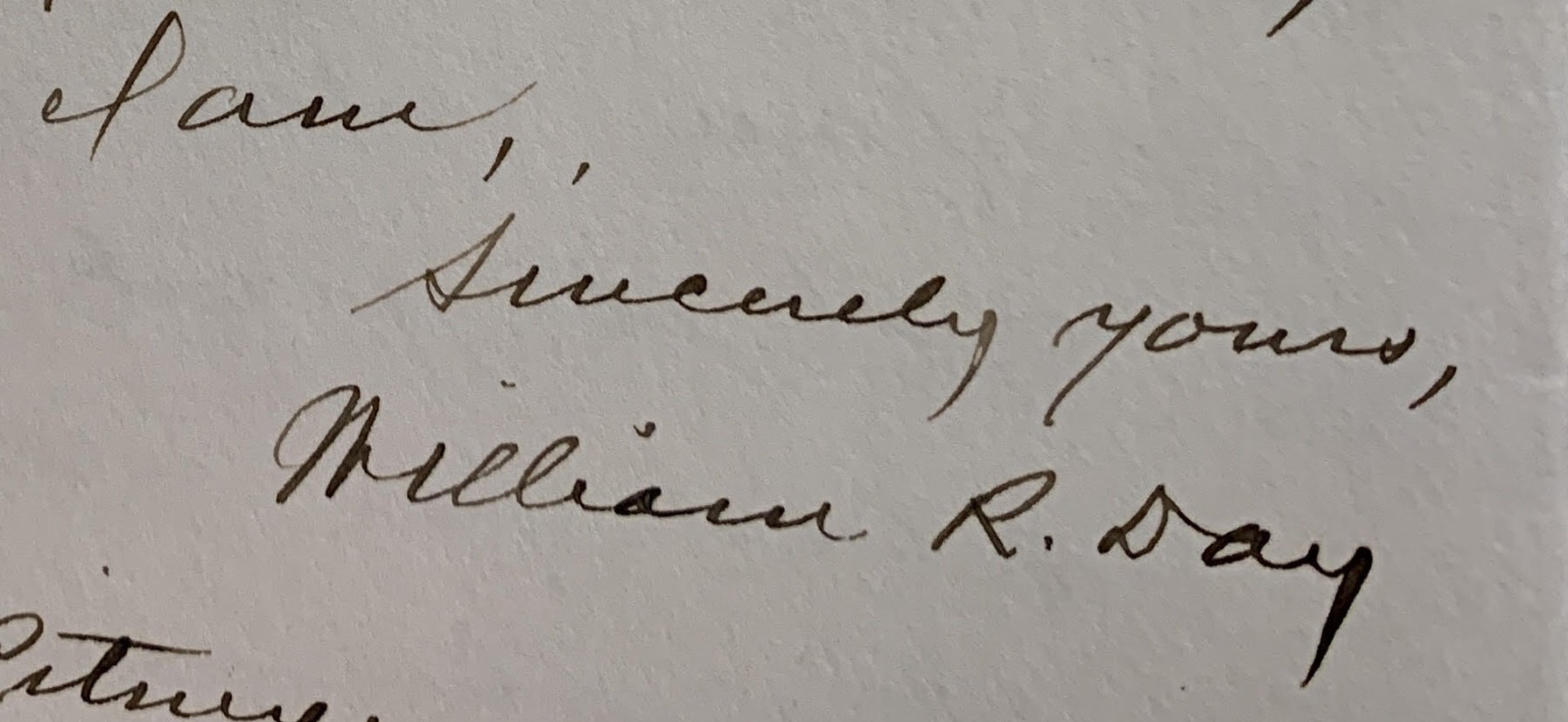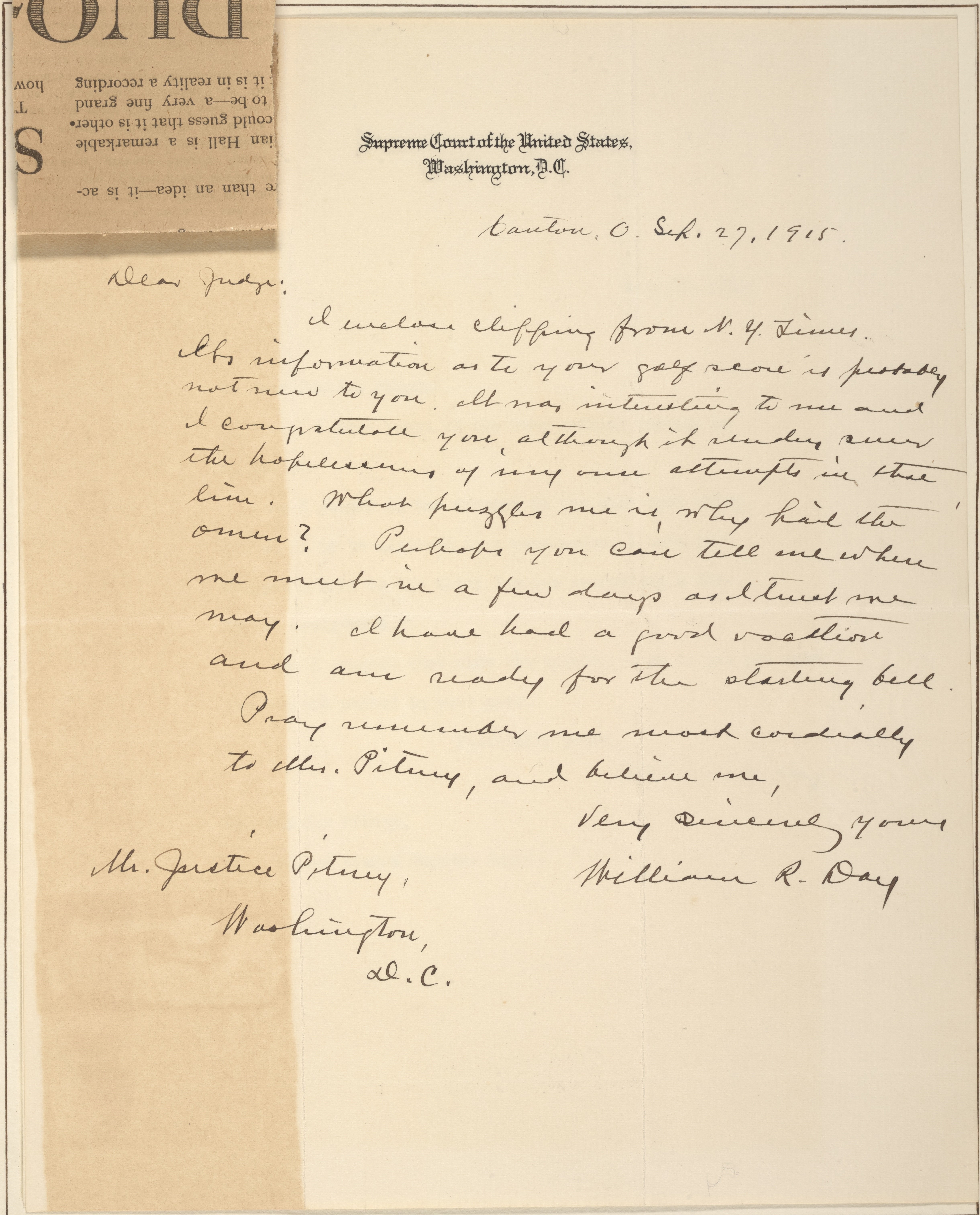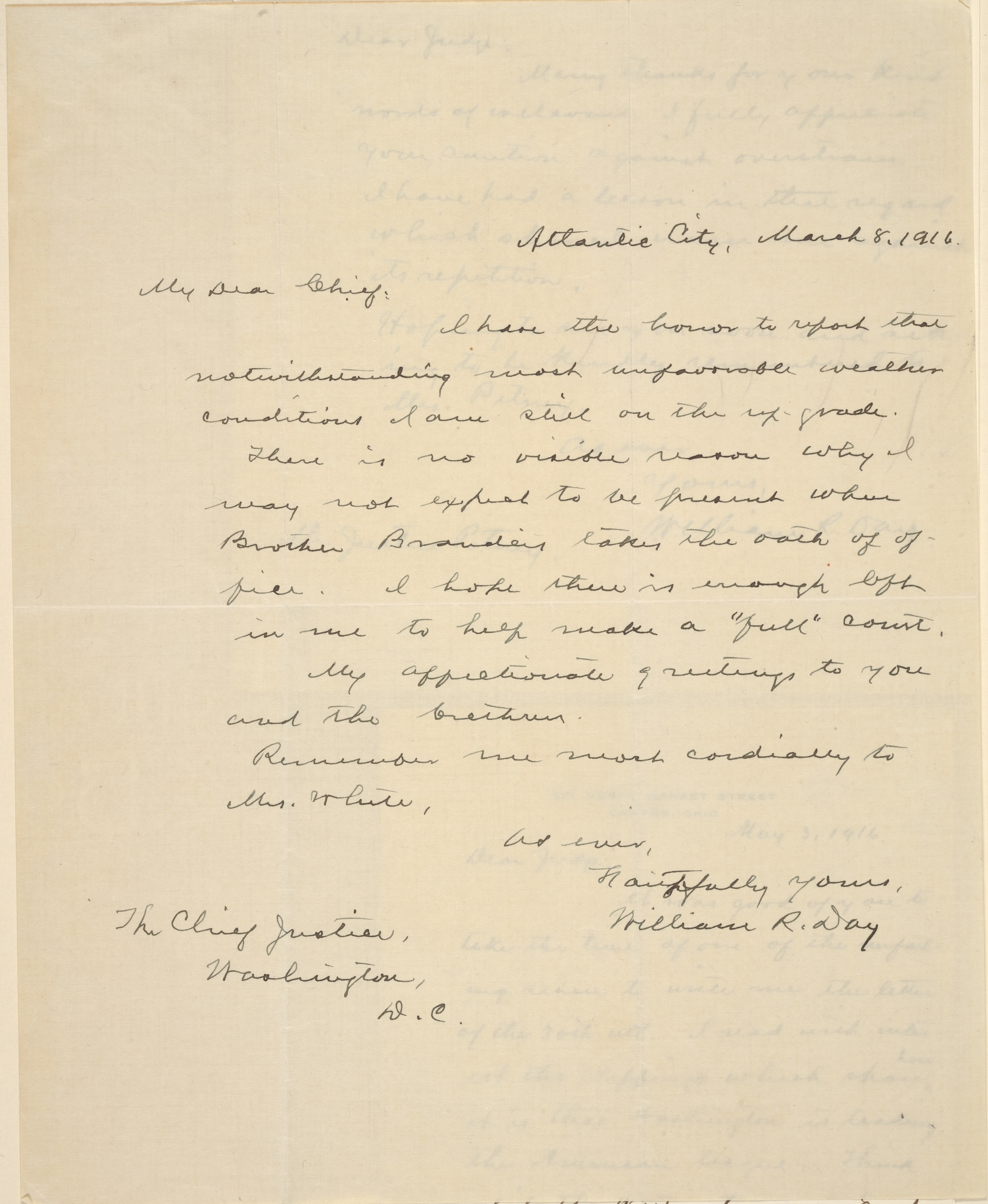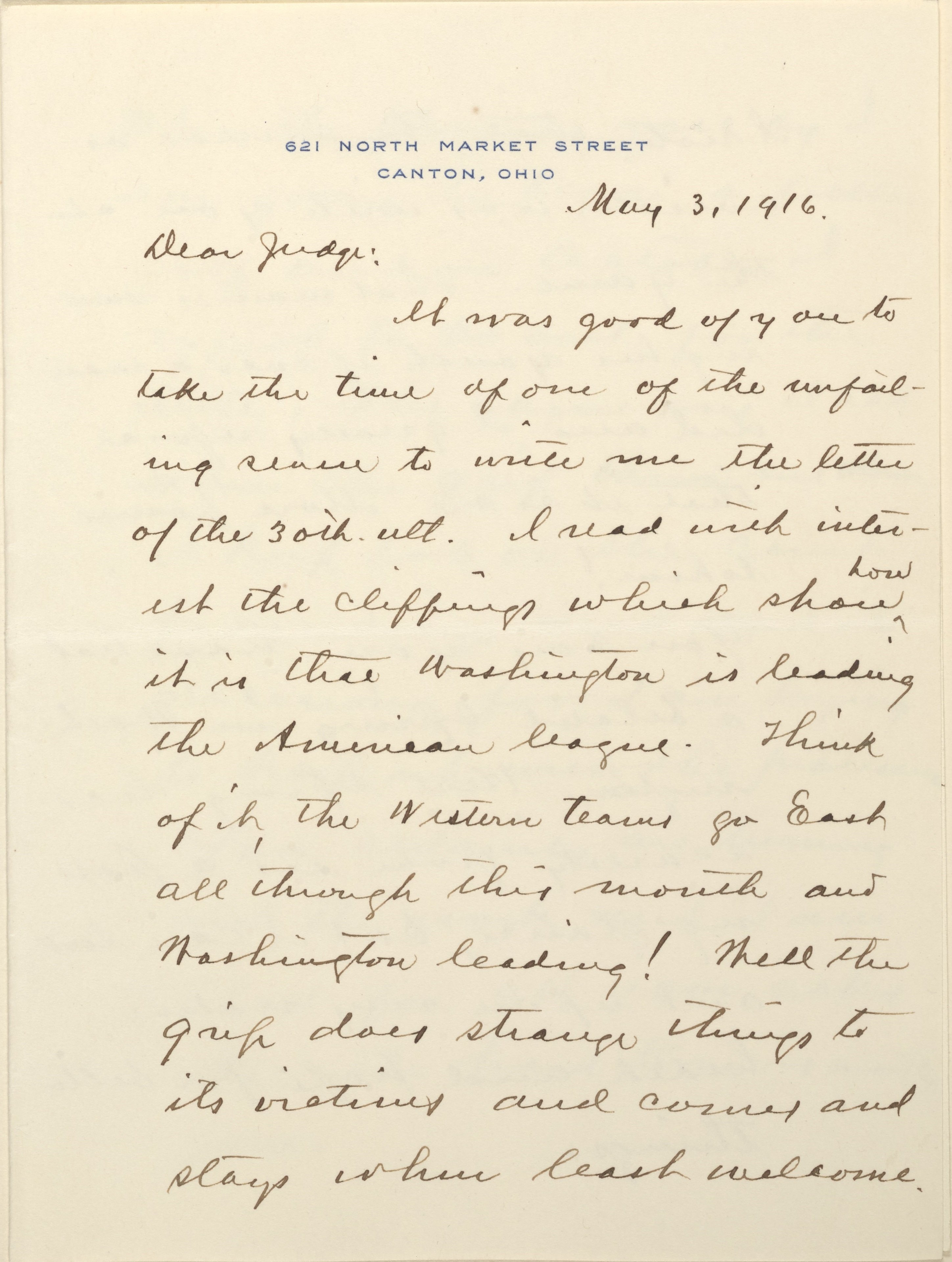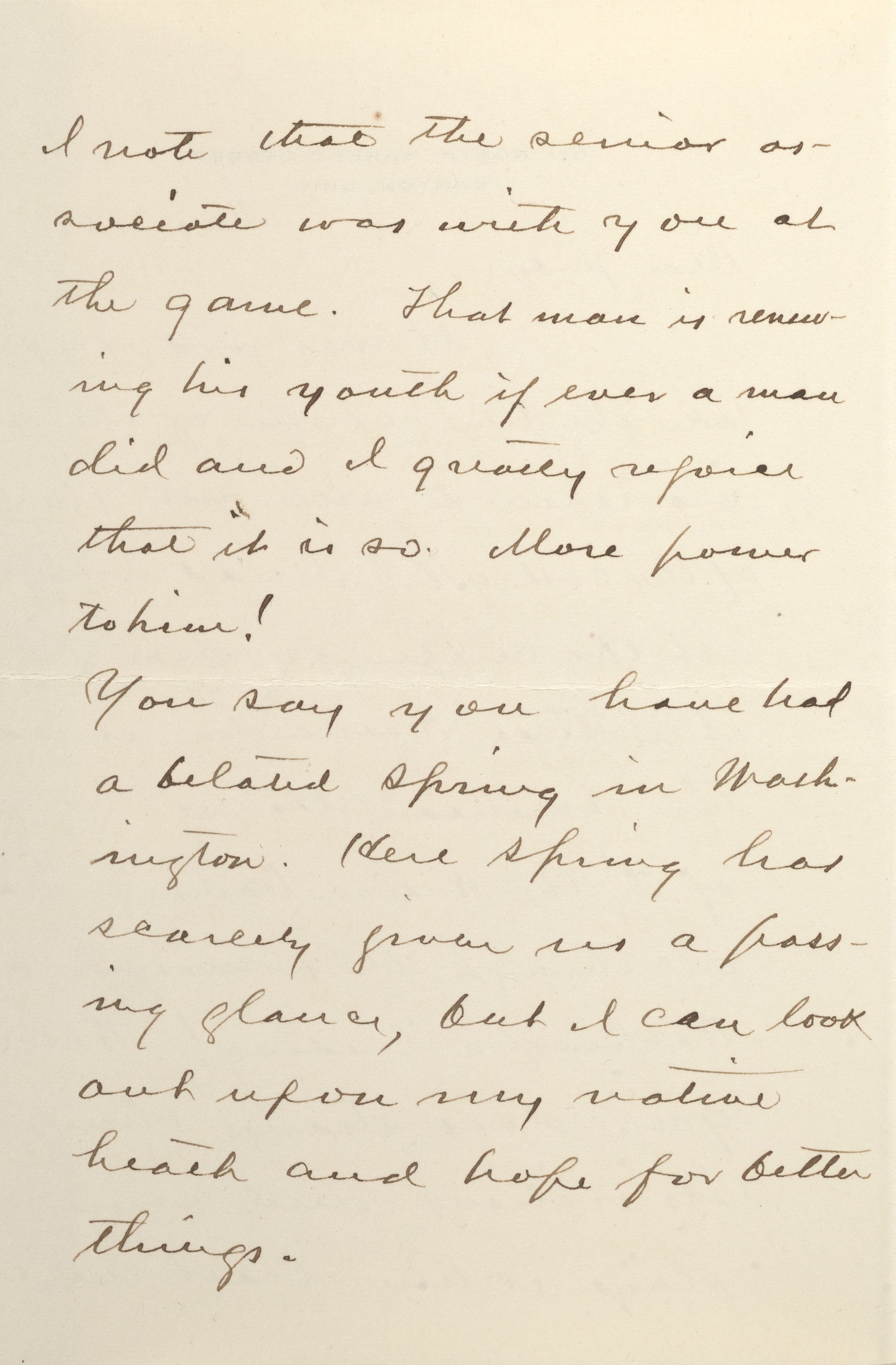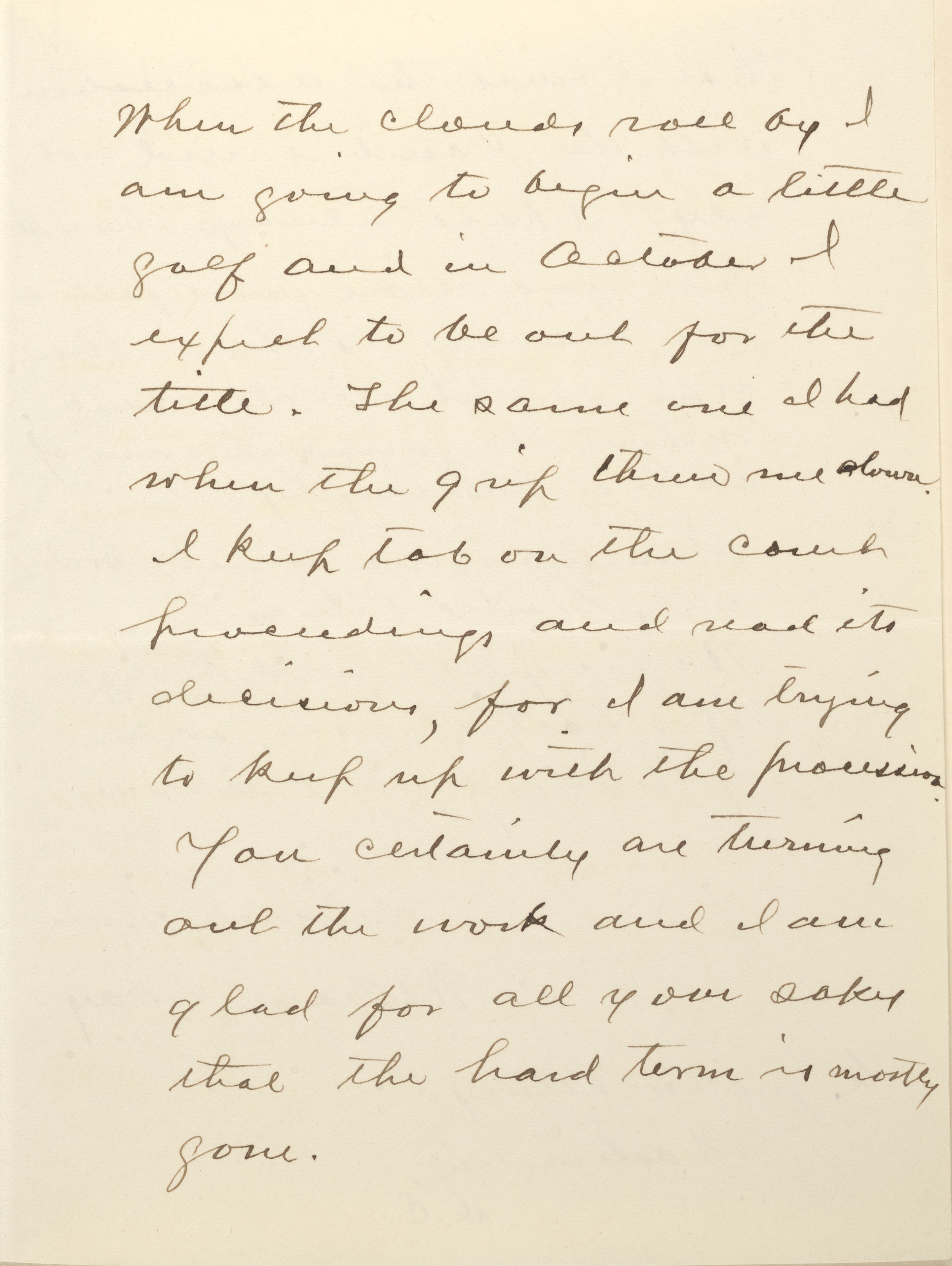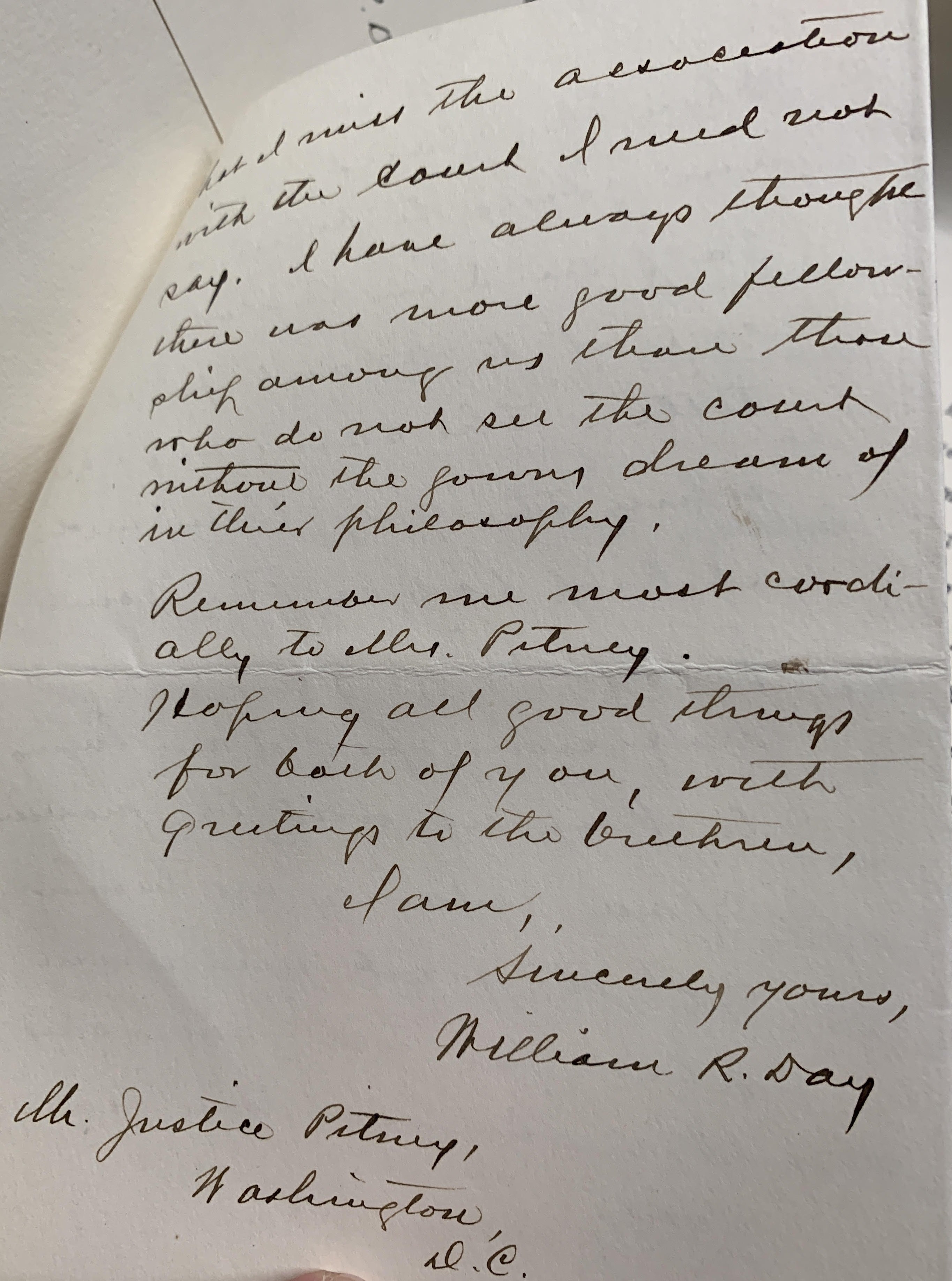William Rufus Day
William Rufus Day (1849-1923) served as an Associate Justice of the United States Supreme Court from 1903 to 1922.
Portrait
Albert Rosenthal, William Rufus Day, n.d., print: etching, United States Supreme Court: Portraits and Autographs, D'Angelo Law Library Rare Book Room, University of Chicago Library.
Signed by the artist, Albert Rosenthal.
Photograph
Harris & Ewing, U.S. Supreme Court, n.d., photograph, United States Supreme Court: Portraits and Autographs, D'Angelo Law Library Rare Book Room, University of Chicago Library.
This photograph of the White Court is undated, but was likely taken between 1912 and 1914 based on who is pictured. Front row: Justices Day and McKenna, Chief Justice White, Justices Holmes and Lurton; Back row: Justices Lamar, Hughes, Van Devanter, and Pitney.

Harris & Ewing, U.S. Supreme Court, n.d., photograph, United States Supreme Court: Portraits and Autographs, D'Angelo Law Library Rare Book Room, University of Chicago Library.
Detail of Justice Day
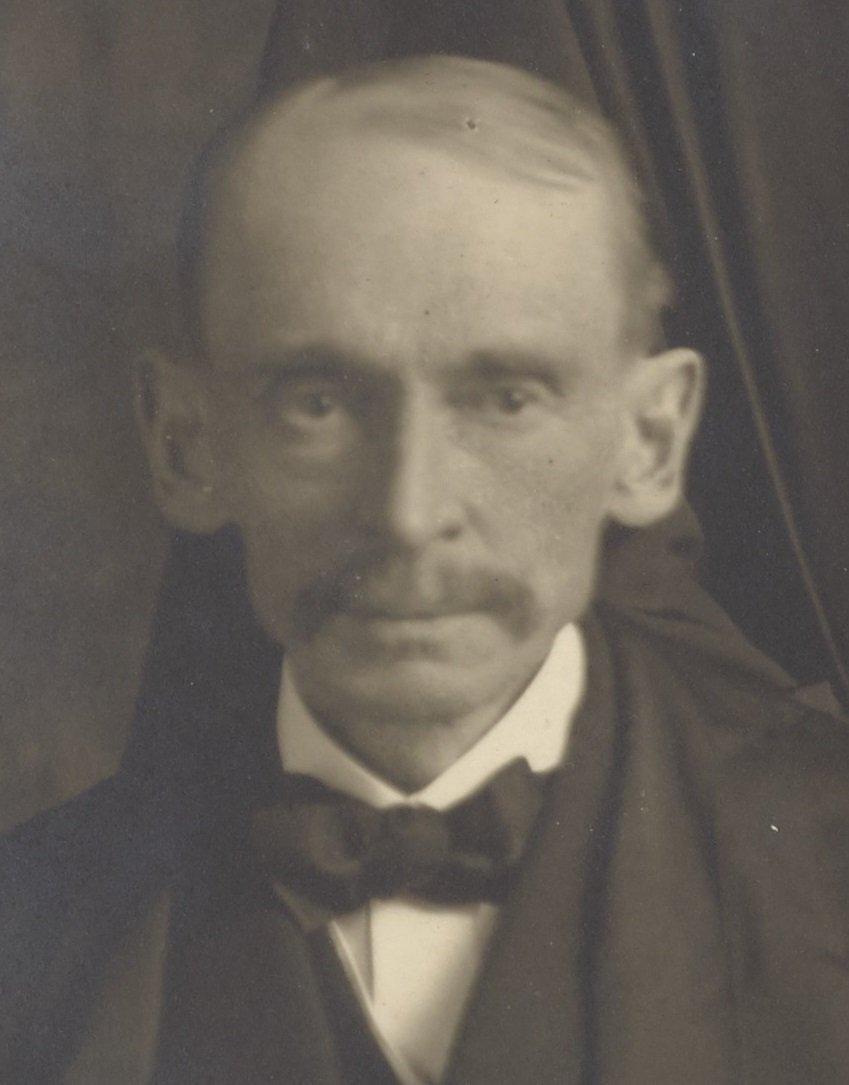
Harris & Ewing, U.S. Supreme Court, n.d., photograph, United States Supreme Court: Portraits and Autographs, D'Angelo Law Library Rare Book Room, University of Chicago Library.
Detail of Justice Day
Signature
Detail from William Rufus Day to Mahlon Pitney, 22 November 1912, United States Supreme Court: Portraits and Autographs, D'Angelo Law Library Rare Book Room, University of Chicago Library.
Detail from William Rufus Day to Mahlon Pitney, 27 September 1915, United States Supreme Court: Portraits and Autographs, D'Angelo Law Library Rare Book Room, University of Chicago Library.
Detail from William Rufus Day to Edward Douglass White, 8 March 1916, United States Supreme Court: Portraits and Autographs, D'Angelo Law Library Rare Book Room, University of Chicago Library.
Detail from William Rufus Day to Mahlon Pitney, 24 March 1916, United States Supreme Court: Portraits and Autographs, D'Angelo Law Library Rare Book Room, University of Chicago Library.
Detail from William Rufus Day to Mahlon Pitney, 3 May 1916, United States Supreme Court: Portraits and Autographs, D'Angelo Law Library Rare Book Room, University of Chicago Library.
The Documents
William Rufus Day to Mahlon Pitney, 22 November 1912
William Rufus Day to Mahlon Pitney, 22 November 1912, United States Supreme Court: Portraits and Autographs, D'Angelo Law Library Rare Book Room, University of Chicago Library.
Transcription of the Letter:
Supreme Court of the United States,
Washington, D.C.
Nov. 22, 1912.
My dear Justice Pitney:
I have yours of the twenty-first instant as to No. 46.
As I joined in the dissent in the case upon which No. 46 is to be affirmed in a memorandum, I have just dropped a note to the Chief Justice suggesting a different assignment.
May I suggest that when the opinion comes to you you make the request stated in your note.
Faithfully yours,
William R. Day
Mr. Justice Pitney,
United States Supreme Court.
William Rufus Day to Mahlon Pitney, 27 September 1915
William Rufus Day to Mahlon Pitney, 27 September 1915, United States Supreme Court: Portraits and Autographs, D'Angelo Law Library Rare Book Room, University of Chicago Library.
Transcription of the Letter:
Supreme Court of the United States,
Washington, D.C.
Canton, O. Sep. 27, 1915.
Dear Judge:
I enclose clipping from N. Y. Times. Its information as to your golf score is probably not new to you. It was interesting to me and I congratulate you, although it renders [ever] the hopelessness of my own attempts in [those lines]. What puzzles me is, why hail the omen? Perhaps you can tell me when we meet in a few days as I trust we may. I have had a good vacation and am ready for the starting bell.
Pray remember me most cordially to Mrs. Pitney, and believe me,
Very sincerely yours,
William R. Day
Mr. Justice Pitney,
Washington,
D.C.
"Apawamis Striplings," New York Times, September 26, 1915, enclosed in William Rufus Day to Mahlon Pitney, 27 September 1915, United States Supreme Court: Portraits and Autographs, D'Angelo Law Library Rare Book Room, University of Chicago Library.
Transcription of the Article:
APAWAMIS STRIPLINGS
When a youth named JAMES ALEXANDER TYNG was younger he used to catch the experiments in trajectory of Pitcher ERNST, now a Boston bacteriologist of credit and renown. Dr. ERNST was wont to whirl around, contemplate the second baseman sternly, gaze implacably at the three fielders, then, revolving with incredible rapidity on his own axis and adamantine legs to "hurl" the ball at the batsman, the catcher, and the universe - bing Tyng! Thus did the future hero of the green revels of Apawamis prepare himself unconsciously for those exercises of distance and velocity wherein he so excels; and now more honors of golf crown the "Apawamis veteran" as the children who make headlines continually do write.
In the name of Methuselah - oh, what an annuitant was lost in that master of the secret of staying on this amusing oblate spheroid! - in the name of the only man who ever reached a ripe age, in the name of the insulted English language, in the name of correct classification, insurrection should be made against the golf grandees, against the infants in the newspaper palaces, against the baby voices that call TYNG and JAMES A. FOOT and other younkers of the green, "Apawamis Veterans," "Seniors" and such terms, innuendo age. Methuselah, it may be admitted for the sake of argument, remains a mark, a terminus. He was the oldest subscriber to this scheme of nights and days. Every life insurance man looks back at him with reverence and regret. He was well along in years. It is likely enough that he was cut off in his prime by a too exclusively rude pastoral diet. But he knew how to last reasonably long. As things are, and until the art of longevity is revived, it is not indecorous to say that he was an old man, a senior, a veteran. Who can think without sniggering of the "patriarchs" of Apawamis? They are in their prime. They are no more "seniors" to the just-poising mind than an infant tugging at the bottle is a senior to the changeling who remembers the oak when it was an acorn.
There should be a revised classification of the Apawamis lads: Class A, 55 to 59 years, preparatory; Class B, 60 to 64 years, middle; Class C, 65 to 69 years, upper middle; Class D, 70 years and upward, sub-freshman. No student in the university of life is a senior till he is 100.
"How old are you, Colonel PERKINS?" Mr. EVARTS asked the brisk young Treasurer of the Norwich & Worcester Railroad, at the Beecher trial. "Only 96, Sir," chirped the smiling witness. Only 96! An admonition and a reproof to the princoxes who range in classes the Apawamis striplings. By the way, Mr. Justice PITNEY of the Supreme Court "made a 92." We hail the omen.
[handwritten underneath by William Rufus Day:] Why? Day
William Rufus Day to Edward Douglass White, 8 March 1916
William Rufus Day to Edward Douglass White, 8 March 1916, United States Supreme Court: Portraits and Autographs, D'Angelo Law Library Rare Book Room, University of Chicago Library.
Transcription of the Letter:
Atlantic City, March 8, 1916
My Dear Chief:
I have the honor to report that notwithstanding most unfavorable weather conditions I am still on the up-grade.
There is no visible reason why I may not expect to be present when Brother Brandeis takes the oath of office. I hope there is enough left in me to help make a "full" court.
My affectionate greetings to you and the brethren.
Remember me most cordially to Mrs. White,
As ever,
Faithfully yours,
William R. Day
The Chief Justice,
Washington,
D.C.
William Rufus Day to Mahlon Pitney, 24 March 1916
William Rufus Day to Mahlon Pitney, 24 March 1916, United States Supreme Court: Portraits and Autographs, D'Angelo Law Library Rare Book Room, University of Chicago Library.
Transcription of the Letter:
1301 Clifton Street
Washington, D.C.
Mar 24, 1916
Dear Judge:
Many thanks for your kind words of welcome. I fully appreciate your caution against overstrain. I have had a lesson in that regard which should warn me against its repetition.
Hoping to see you soon and asking to be kindly remembered to Mrs. Pitney,
As ever,
Yours,
William R. Day
Mr. Justice Pitney.
William Rufus Day to Mahlon Pitney, 3 May 1916
William Rufus Day to Mahlon Pitney, 3 May 1916, United States Supreme Court: Portraits and Autographs, D'Angelo Law Library Rare Book Room, University of Chicago Library.
William Rufus Day to Mahlon Pitney, 3 May 1916, United States Supreme Court: Portraits and Autographs, D'Angelo Law Library Rare Book Room, University of Chicago Library.
William Rufus Day to Mahlon Pitney, 3 May 1916, United States Supreme Court: Portraits and Autographs, D'Angelo Law Library Rare Book Room, University of Chicago Library.
William Rufus Day to Mahlon Pitney, 3 May 1916, United States Supreme Court: Portraits and Autographs, D'Angelo Law Library Rare Book Room, University of Chicago Library.
Transcription of the Letter:
621 North Market Street
Canton, Ohio
May 3, 1916.
Dear Judge:
It was good of you to take the time of one of the unfailing [season] to write me the letter of the 30th ult. I read with interest the clippings which show how it is that Washington is leading the American league. Think of it, the Western teams go East all through this month and Washington leading! Well the grip does strange things to its victims and comes and stays when least welcome.
I note that the senior associate was with you at the game. That man is renewing his youth if ever a man did and I greatly rejoice that it is so. More power to him!
You say you have had a belated spring in Washington. Here spring has scarcely given us a passing glance, but I can look out upon my native heath and hope for better things. When the clouds roll by I am going to begin a little golf and in October I expect to be out for the title. The same one I had when the grip threw me down.
I keep tab on the court proceedings and read its decisions, for I am trying to keep up with the procession. You certainly are turning out the work and I am glad for all your sakes that the hard term is mostly gone.
That I miss the association with the Court I need not say. I have always thought there was more good fellowship among us than those who do not see the Court without the gowns dream of in their philosophy.
Remember me most cordially to Mrs. Pitney.
Hoping all good things for both of you, with greetings to the brethren,
I am,
Sincerely yours,
William R. Day
Mr. Justice Pitney,
Washington, D.C.
About these Documents
About Justice Mahlon Pitney
When William Rufus Day sent these 1912, 1915 and 1916 letters to Mahlon Pitney, both men were serving as Associate Justices on the U.S. Supreme Court. Pitney joined Day on the Court in 1912, after having been nominated by President William H. Taft. Before his service on the Court, Pitney had an active legal and political career in New Jersey.
For more about Justice Mahlon Pitney, see:
- "Pitney, Mahlon," Federal Judicial Center, accessed July 18, 2019, https://www.fjc.gov/history/judges/pitney-mahlon.
- "PITNEY, Mahlon (1858-1924)," Guide to Research Collections, Biographical Directory of the United States Congress, accessed July 18, 2019, http://bioguide.congress.gov/scripts/guidedisplay.pl?index=P000370.
- "Manuscript Group 1128, Pitney Family and Farm Papers, 1803 – 1951," The New Jersey Historical Society, accessed July 19, 2019, https://jerseyhistory.org/manuscript-group-1128-pitney-family-and-farm-papers-1803-1951/.
About Edward Douglass White
In 1916 when William Rufus Day wrote to Edward Douglas White, White was serving as the Chief Justice of the U.S. Supreme Court, a position he had held since his nomination in 1910 by President William Howard Taft. Before that, White served as an Associate Justice of the U.S. Supreme Court from 1894 to 1910. He was nominated for that position by President Grover Cleveland.
For more about Edward Douglass White, see:
- "White, Edward Douglass," Federal Judicial Center, accessed July 19, 2019, https://www.fjc.gov/history/judges/white-edward-douglass.
- "WHITE, Edward Douglass (1845-1921)," Guide to Research Collections, Biographical Directory of the United States Congress, accessed July 18, 2019, http://bioguide.congress.gov/scripts/guidedisplay.pl?index=W000366.
- Follow this link to search the University of Chicago Library catalog for the subject heading "White, Edward Douglass, 1845-1921".
About Louis Dembitz Brandeis
In the letter to Chief Justice White, Day writes that he hopes to be well enough to attend the ceremony at which Louis Dembitz Brandeis will take the oath of office. Justice Brandeis was nominated to the position of Associate Justice of the U.S. Supreme Court in January of 1916 by President Woodrow Wilson, and then confirmed by the Senate in June of that year.
For more about Louis Dembitz Brandeis, see:
- "Brandeis, Louis Dembitz," Federal Judicial Center, accessed July 19, 2019, https://www.fjc.gov/history/judges/brandeis-louis-dembitz.
- Follow this link to search the University of Chicago Library catalog for the subject heading "Brandeis, Louis Dembitz, 1856-1941".
About the Washington Nationals/Senators
In the letter William Rufus Day sent to one of his colleagues on the Court in May of 1916, he seems surprised to have read that Washington's baseball team was leading in the American League so far that season. Unfortunately for Justice Day, the Washington Nationals (frequently referred to as the Senators) did not finish the season quite as strongly: they ended the season ranked seventh of eight teams. In 1961 the team moved to Minnesota to become the Twins and Washington got a new expansion team named the Washington Senators. In 1972, that team moved to Texas to become the Texas Rangers. Washington would not have a Major League Baseball team again until 2005, when the Montreal Expos moved to Washington to become the Washington Nationals.
For more about the Washington Senators, see:
- "Minnesota Twins," Baseball Almanac, accessed July 19, 2019, https://www.baseball-almanac.com/teams/minn.shtml.
- "1916 Washington Senators Statistics," Baseball-Reference, accessed July 19, 2019, https://www.baseball-reference.com/teams/WSH/1916.shtml.
- "Texas Rangers," Baseball Almanac, accessed July 22, 2019, https://www.baseball-almanac.com/teams/rang.shtml.
- "Washington Nationals History and Montreal Expos History," Baseball Almanac, accessed July 22, 2019, https://www.baseball-almanac.com/teams/washington_nationals.shtml.
About William Rufus Day
William Rufus Day began his career as an attorney in private practice in Canton, Ohio. In 1897, President William McKinley appointed Day Assistant Secretary of State and then Secretary of State in 1898. President McKinley later nominated Day as judge for the U.S. Circuit Courts for the Sixth Circuit and the U.S. Court of Appeals for the Sixth Circuit, a position he held until his elevation to the U.S. Supreme Court.
William Rufus Day was nominated to the U.S. Supreme Court by President Theodore Roosevelt in 1903. He served as an Associate Justice until his retirement in 1922.
For more about William Rufus Day's life and career, see:
- Follow this link to search the University of Chicago Library catalog for the subject heading "Holmes, Oliver Wendell, Jr., 1841-1935".
- "Day, William Rufus" Federal Judicial Center, accessed July 19, 2019, https://www.fjc.gov/history/judges/day-william-rufus.
- Lists background information on his professional career as well as a list of manuscript collections.
- "William R. Day papers, 1820-1923," Library of Congress Finding Aid, Library of Congress, accessed July 19, 2019, http://hdl.loc.gov/loc.mss/eadmss.ms011204.

